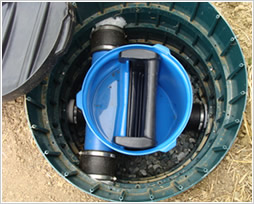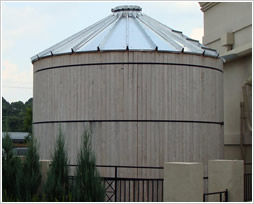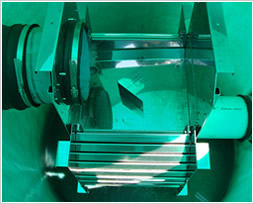 RAINSTORE
RAINSTORE

RainStore-USA
RAINWATER COLLECTION SYSTEM COMPONENTS
- Catchment Surface: The collection surface from which the rainwater runs off. There are three most common types of roofing components:
- Metal – suitable for potable or non-potable use
- Clay or Concrete Tile – suitable for potable or non-potable use
- Composite or Asphalt Shingle – non-potable use only
- Others include wood shingle, tar, slate and gravel.
 Conveyance - Gutters and Downspouts: These channel water from the roof through filters and then to a storage/containment vessel. All the downspouts can be routed to 1) individual filtering units attached to one or several downspouts or 2) one or several filter(s) that are buried but accessible just below the ground surface or just inside the storage tank, or 3) a combination of these options may also be appropriate. The designer intent is to bring the water to a central point for storage and use.
Conveyance - Gutters and Downspouts: These channel water from the roof through filters and then to a storage/containment vessel. All the downspouts can be routed to 1) individual filtering units attached to one or several downspouts or 2) one or several filter(s) that are buried but accessible just below the ground surface or just inside the storage tank, or 3) a combination of these options may also be appropriate. The designer intent is to bring the water to a central point for storage and use.- Filters, Leaf screens, debris traps, first flush diverters and/or roof washers: These are components which remove debris, dust and dirt from the captured rainwater before, during or after they enter the downspouts and/or the storage tank often referred to as a Cistern. The rainwater can be filtered and diverted to the tank in several different ways.
 Rainwater Storage/Containment Vessel or Cistern: The typical storage tank size ranges from 50 to 15,000 gallons for residential systems and 5,000 to 100,000 gallons or more for commercial systems. Most tanks are typically in either a vertical cylinder or low-horizontal cylinder configuration. Depending on the site suitability storage tanks can be located above ground or below ground and are constructed of various materials.
Rainwater Storage/Containment Vessel or Cistern: The typical storage tank size ranges from 50 to 15,000 gallons for residential systems and 5,000 to 100,000 gallons or more for commercial systems. Most tanks are typically in either a vertical cylinder or low-horizontal cylinder configuration. Depending on the site suitability storage tanks can be located above ground or below ground and are constructed of various materials.
Common storage vessel materials are as follows:
Plastic: The most common and practical material currently in use for tanks are polypropylene/polyethylene and can be constructed for both above and below ground systems. Chambers and/or subsurface cavern systems which typically use liners and geo-membranes are also most often constructed of plastic.
Fiberglass: Although typically more expensive than plastic, these are also commonly used and can be for both above ground and below ground systems.
Pre-Cast/Concrete/Masonry:
Ferro cement
Stone/Concrete Block
Pre-Cast/Monolithic/Poured in-place
Metal: Steel, Galvanized Steel/or sheet metal
Wood: Commonly used above ground with an impermeable liner inside the tank. Treatment/purification: Filters and other methods of treatment include but are not limited to screen mesh, sand filtration or membrane for non-potable use.
Treatment/purification: Filters and other methods of treatment include but are not limited to screen mesh, sand filtration or membrane for non-potable use.
UV disinfection and/or reverse osmosis may be necessary for potable use.
The level of filtration and treatment will depend on the end use.- Distribution & System Controls: The stored rainwater can be gravity fed for small systems (rain barrels) but most owners desire the water to be pumped to its end use. Plumbers or someone familiar with pumps are recommended for these more complex and/or commercial systems to ensure the system functionality is consistent with standard practices. A float system, pneumatic or remote sonic device that measures the water level in the tank is typically mounted either at or in the tank. A control panel or digital readout device is typically mounted in the building. There are various types of system controls that monitor the water level in the tank and switch automatically to fill or by-pass the tank with municipal supply and/or well water. Mechanical back-up valves are commonly used to maintain a constant water level in the tank regardless of the amount of rain collected. The amount of total harvested rainwater versus replenishment water can also be monitored. Plumbing codes typically require backflow prevention and/or an air gap to ensure communication does not occur between the harvested rainwater and the water mains.

Product Catalog
Rainwater
Harvesting
Products
Call for Pricing
1-888-918-5436
Receive fast
written quotations


